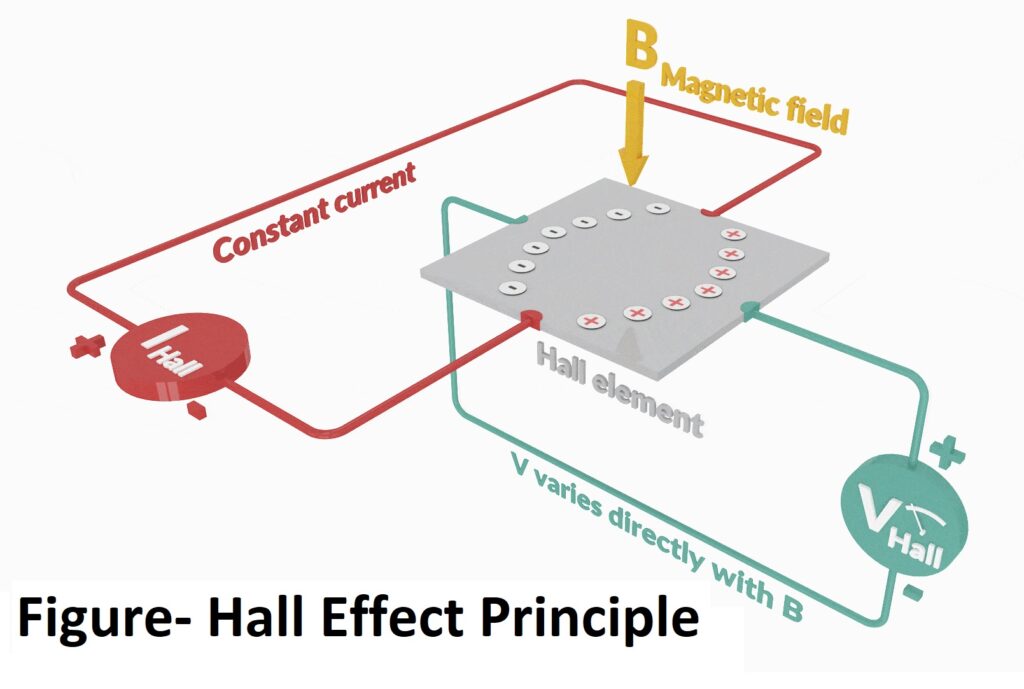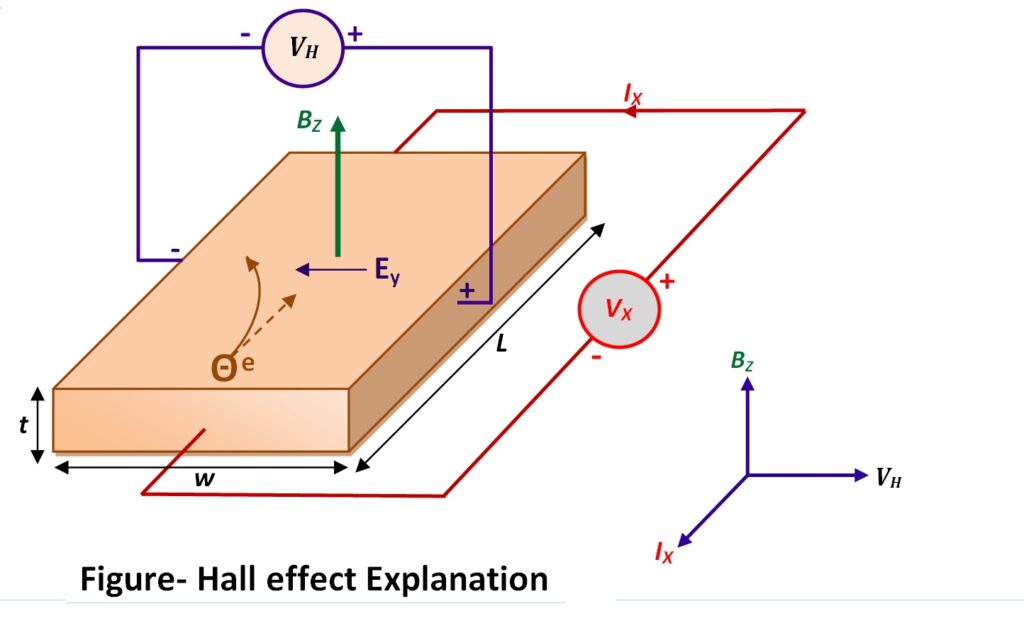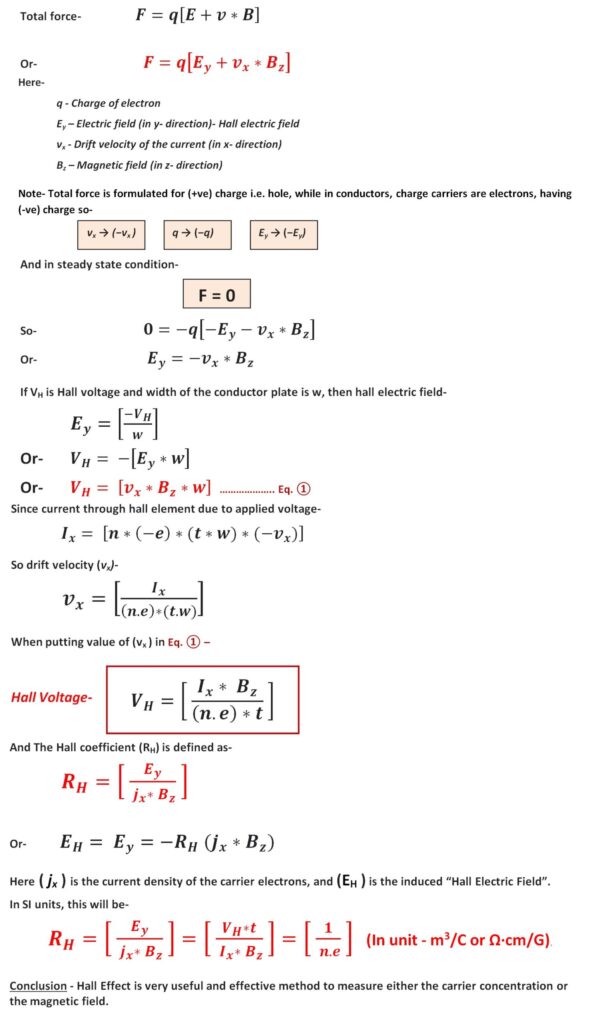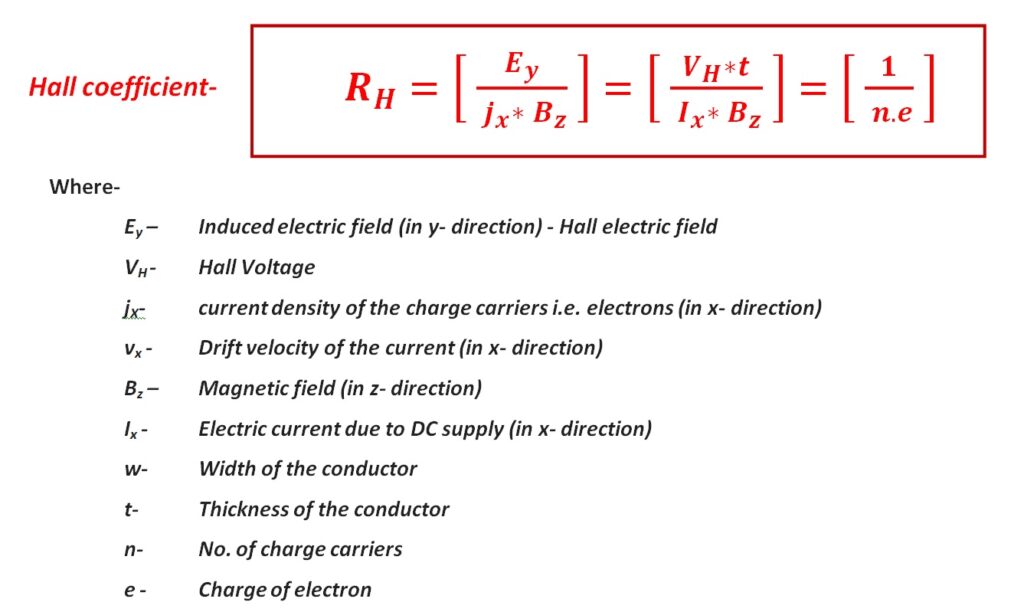Table of Contents
Hall Effect is an important transport phenomenon applicable for conductor and semiconductor materials extensively used for detection of charge carriers’ concentration or magnetic field around it or current through it. When a current carrying solid material is introduced to a magnetic field perpendicular to the direction of current, a transverse electric field is developed hence a voltage is produced. This is called as Hall Voltage, and this phenomenon is called as ‘Hall Effect’.
Hall Effect principle-
The Hall Effect principle states that when a current-carrying conductor or a semiconductor is placed in a perpendicular magnetic field, a transverse voltage is produced or measured at the right angle to the current path. This effect of obtaining a measurable voltage across material is known as the Hall Effect. And this transverse voltage is referred as Hall Voltage. To explain theory behind, a diagram is shown below-

When a conductive plate is connected to a circuit containing a DC supply, a current begins to flow. The charge carriers will follow a approximately straight, ‘line of sight’. Thus, magnetic fields arise as a result of the movement of charge carriers while external magnetic field is absent. When the magnet is placed near the plate as a perpendicular component to the current flow, the magnetic field of the charge carriers gets distorted. This produces a disturbance in the direct flow of charge carriers. The force which deviate the direction of the flow of charge carriers is known as the Lorentz force.





Here asymmetric distribution of charge density across the Hall element arises from a force that is perpendicular to both the ‘line of sight’ path and the applied magnetic field. This establishes an electric field that opposes the migration of further charge carriers and so a steady electric potential is established as result of the charge flowing for longer duration. This is called as Hall voltage (VH).
Hall Effect derivation –
For a simple metal where there are only electrons as charge carriers, the Hall voltage (VH) can be derived by using the Lorentz force and seeing that, in the steady-state condition, charge carriers are not moving in the y-axis direction. Thus, the magnetic force on electrons in the y-axis direction is cancelled by a y-axis electrical force due to the buildup of charges. So-





Note- Hall Effect is used to measure carrier concentration or magnetic field.
Hall voltage formula –
The Hall voltage (VH) is defined as-





Hall Coefficient formula –
The Hall coefficient (RH) is defined as-





Note- Hall coefficient (RH) is measured mostly in known units such as – “m3/C” or “Ω·cm/Gauss” or “Ω·cm/G”
Hall Effect in semiconductors-
Hall Effect in semiconductors is similar like in conductors. The difference is when a voltage is applied to a conductor, electric current flow due to free electrons only. While in semiconductors, when applying voltage, current is conducted due to both free electrons as well as holes. There are 2 types of semiconductors – Intrinsic type and extrinsic type, and again extrinsic semiconductors are classified as p-type extrinsic and n- type extrinsic semiconductors. hall coefficient for semiconductor material is defined as-
![]()
![]()
![]()
![]()
![]()
Hall Effect in different materials-
- In conductors, current flows due to free electrons, so hall coefficient is negative. I.e. direction of produced Hall Electric field is negative y- direction. In metals, Hall Effect voltage is extremely small and difficult to measure.
- In intrinsic semiconductor, there is equal concentration of free electrons and holes in thermal equilibriums, so here ideally hall coefficient is expected to be zero, but since Hall Effect depends on conductivity & conductivity depends on mobility and also mobility of electrons is more than holes. So intrinsic semiconductors behave more as n type, thus Hall coefficient is somewhat towards negative.
- In P- type semiconductors, the electric field and current is primarily due to holes as holes are majority carriers. This leads hall voltage positive and Hall coefficient is positive for p- type semiconductors. So direction of produced Hall Electric field is positive y- direction.
- In N- type semiconductors, the electric field and current is primarily due to free electrons as electrons are majority carriers. This leads hall voltage negative and Hall coefficient is negative for n- type semiconductors. So direction of produced Hall Electric field is negative y- direction.
- In insulators, there are no free electrons and so there is no current flow through material when connected to a DC supply, so there is no hall voltage produced and hall coefficient is zero.
Application of Hall Effect-
Hall Effect principle is applied on the following cases-
- Hall Effect can be used to measure carrier concentration and magnetic field intensity.
- It is used to determine type of material i.e. which semiconductor (p type or n- type) or metal.
- It is used to calculate mobility or charge carriers, conductivity of material.
- Hall Effect is used for measurement of direct current, Hall Effect Tong Tester
- In magnetic field sensing equipment
- It is used in phase angle measurement
- In proximity detector
- In Hall effect Sensors and hall probes
- Linear or Angular displacement transducers
- For detecting wheel speed and accordingly assist the ABS – anti-lock braking system.
Related Search:-